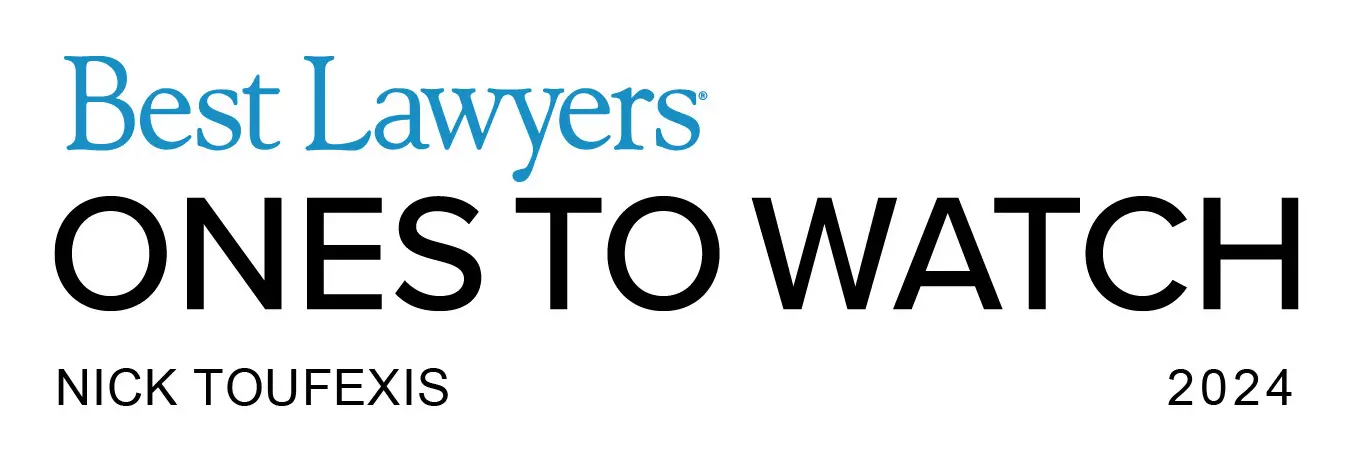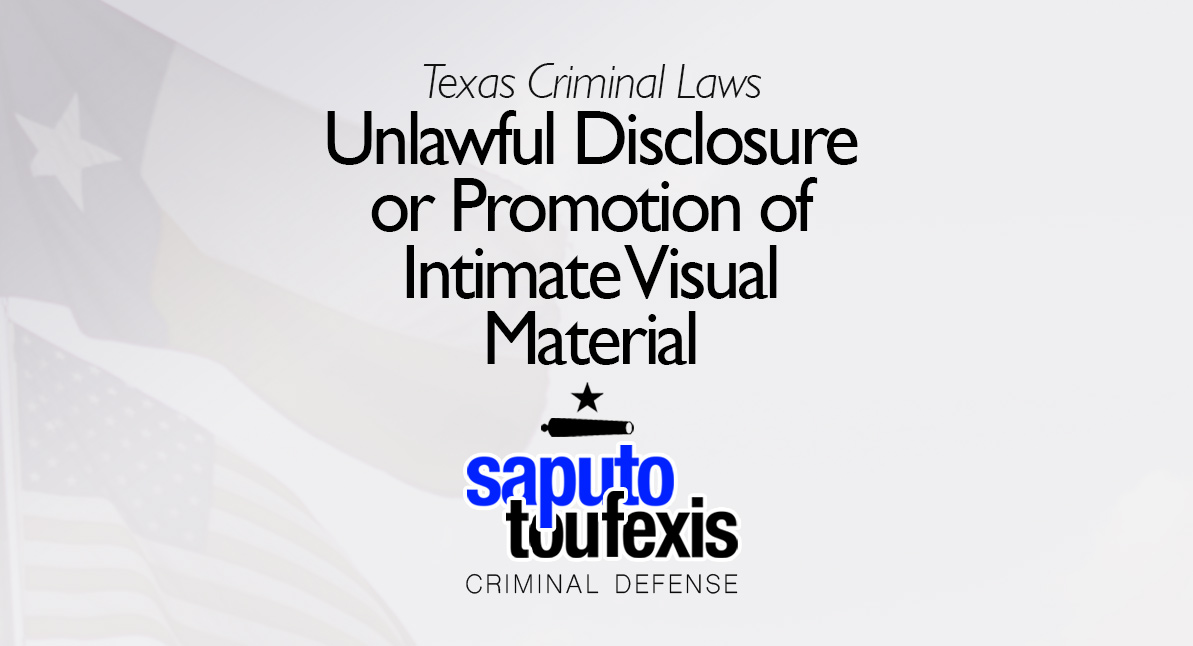The Texas Unlawful Disclosure or Promotion of Intimate Visual Material law is the “Revenge Porn” law, and it restricts what you can do with photographs and videos depicting nudity or sexual conduct.
FAQs about the
Unlawful Disclosure or Promotion of Intimate Visual Material law in Texas
- What is the current Texas law about Revenge Porn or Unlawful Disclosure or Promotion of Intimate Visual Material?
- What are the affirmative defenses to the Revenge Porn law?
- What visual material is covered?
- What if the person consented to the creation of the photos or sent them to me?
- What is the statute of limitation for Unlawful Disclosure or Promotion of Intimate Visual Material in Texas?
- What is the penalty for a Texas Unlawful Disclosure or Promotion of Intimate Visual Material offense?
- Can you get probation for Unlawful Disclosure or Promotion of Intimate Visual Material in Texas?
- Do I have to register as a sex offender in Texas if guilty of Unlawful Disclosure or Promotion of Intimate Visual Material?
- What level of crime is Unlawful Disclosure or Promotion of Intimate Visual Material in Texas?
The Texas legislature codified this criminal offense in Texas Penal Code Section 21.16. The law was not amended in 2023. However, the law was most recently amended in 2019, when the legislature added an “intent to harm” element as well as a “knowledge” element to subsection (b).
Have you been charged with Unlawful Disclosure or Promotion of Intimate Visual Material? Contact us today to discuss legal representation.
or Text or Call (888) 239-9305
The Revenge Porn law applies to photographs and videos that depict “another person with the person’s intimate parts exposed or engaged in sexual conduct.” The law says that these photos can’t be posted on the internet or sent anywhere else without the depicted person’s consent if the individual would be harmed and also could be identified. The law also prohibits using the release of types of photos in a threatening manner.
Enacted in 2015 by the “Relationship Privacy Act” (the “RPA”), the Texas state legislature created both criminal and civil liabilities for people who disclose so-called “Revenge Porn.” The law in the Penal Code also describes three affirmative defenses and describes two circumstances that may not be used as a defense.
The Penal Code classifies the Texas Unlawful Disclosure or Promotion of Intimate Visual Material law under Title 5 “Offenses Against the Person,” Chapter 21 “Sexual Offenses.” Learn more about the Texas offense of Unlawful Disclosure or Promotion of Intimate Visual Material below.
What is the current Texas law about Revenge Porn or Unlawful Disclosure or Promotion of Intimate Visual Material?
The offense is described in Section 21.16 of the Texas Penal Code.[1] This statute describes three different ways to violate the Revenge Porn law. The first way to violate this law is found in Subsection (b). The legislature amended this subsection in 2019 by adding an “intent to harm” element as well as a “knowledge” element and took effect in September 2019.[2] These changes are indicated below with the added language in brackets and the removed language with strikethrough:
A person commits an offense if:
(1) without the effective consent of the depicted person [and with the intent to harm that person], the person
intentionallydiscloses visual material depicting another person with the person’s intimate parts exposed or engaged in sexual conduct;(2) [at the time of the disclosure, the person knows or has reason to believe that] the visual material was obtained by the person or created under circumstances in which the depicted person had a reasonable expectation that the visual material would remain private;
(3) the disclosure of the visual material causes harm to the depicted person; and
(4) the disclosure of the visual material reveals the identity of the depicted person in any manner, including through:
(A) any accompanying or subsequent information or material related to the visual material; or
(B) information or material provided by a third party in response to the disclosure of the visual material.
In order to obtain a conviction under this subsection (b), the state’s attorneys must prove five main elements: (1) the visual material depicts another person with the person’s intimate parts exposed or engaged in sexual conduct, (2) the accused person intentionally disclosed the visual material [in the 2019 version, disclosure must be made with an intent to harm], (3) the the disclosure was without the effective consent of the other person, (4) the depicted person had a reasonable expectation of privacy [in the 2019 version, the accused must also know or should have known about such an expectation], (5) the disclosure causes harm and (6) the disclosure reveals the identity of the depicted person.
This subsection addresses the most typical revenge porn scenario where a former lover publishes an intimate picture of his or her “ex” on the Internet.
There are some interesting things to consider about this definition. First, the use of the word “causes” implies that there must be some ongoing harm. Second, what does the reasonableness of an expectation of privacy cover? It would obviously cover unauthorized photos of someone in a restroom, but whether anyone would have a reasonable expectation of privacy for photos that they agreed to have taken seems outlandish. Having someone else take a picture would require you to have given up your expectation of privacy to at least one other person. The use of the word “effective” in “effective consent” means that consent does not have to be expressly authorized, which would leave a lot of leeway in interpretation.
Subsection (c) of Section 21.16 describes the second way to violate the law:
A person commits an offense if the person intentionally threatens to disclose, without the consent of the depicted person, visual material depicting another person with the person’s intimate parts exposed or engaged in sexual conduct and the actor makes the threat to obtain a benefit:
(1) in return for not making the disclosure; or
(2) in connection with the threatened disclosure.
This subsection makes it illegal to use the sensitive visual material in a threatening way. The law, however, does not apply to every kind of threat. It only applies to threats made to obtain a benefit, and then further limited to only threats made to obtain a benefit in exchange for not disclosing the material or threats made to obtain a benefit in connection with the threatened behavior.
Subsection (d) of Section 21.16 describes the third way to violate the law:
A person commits an offense if, knowing the character and content of the visual material, the person promotes visual material described by Subsection (b) on an Internet website or other forum for publication that is owned or operated by the person.
This subsection specifically addresses the Internet, although it applies to other forums for publication as well. The key difference between this subsection of the law and the others is the use of the word “promote.” Promote is defined under the law as “to procure, manufacture, issue, sell, give, provide, lend, mail, deliver, transfer, transmit, publish, distribute, circulate, disseminate, present, exhibit, or advertise or to offer or agree to do any of the above.”[3] This is a very broad definition, and it covers a lot more kinds of actions than what is covered under Subsection (b). Subsection (b) only covers the “disclosure” of visual materials.
One gray area in the Revenge Porn law is what the legislature intended by “visual material described by Subsection (b).” It is unclear whether the legislature meant “visual material depicting another person with the person’s intimate parts exposed or engaged in sexual conduct” or the visual material that also meets the criteria of the rest of subsection (a), including (a)(1),(2),(3) and (4).
What are the affirmative defenses to the Revenge Porn law?
There are three affirmative defenses to prosecution under this law. However, none of them apply to a prosecution under subsection (c),[4] the use of the visual material as part of a threat. The first affirmative defense would allow you to avoid a conviction if you show that the disclosure of the intimate material was made as part of a law enforcement investigation, medical treatment, legal proceeding or reporting an unlawful activity.[5]
The second affirmative defense requires you to show that the the visual material was made in a “public or commercial setting” and was voluntary, and it is further limited to visual material only of the person’s “intimate parts” or the person engaging in sexual conduct.[6] So if you take a photograph of a woman “flashing” someone at a concert, for instance, this would be covered under this second affirmative defense.
The third affirmative defense[7] covers the unusual situation where the actor that discloses the photos is an “interactive computer service, as defined by 47 U.S.C. Section 230.”[8]
What visual material is covered?
Visual material includes “any film, photograph, videotape, negative, or slide or any photographic reproduction that contains or incorporates in any manner any film, photograph, videotape, negative, or slide” and “any disk, diskette, or other physical medium that allows an image to be displayed on a computer or other video screen and any image transmitted to a computer or other video screen by telephone line, cable, satellite transmission, or other method.”[9]
What if the person consented to the creation of the photos or sent them to me?
The law states that you cannot use the fact that the depicted person sent the photos to you as a defense.[10] It also states that you cannot use the fact that depicted person consented to the taking of the photos or videos or that he or she took them himself or herself.[11]
What is the statute of limitation for Unlawful Disclosure or Promotion of Intimate Visual Material in Texas?
Unlawful Disclosure or Promotion of Intimate Visual Material offenses have a three-year limitations period.[12]
What is the penalty for a Texas Unlawful Disclosure or Promotion of Intimate Visual Material offense?
A conviction for Unlawful Disclosure or Promotion of Intimate Visual Material is punished as a Class A misdemeanor,[13] with a maximum possible fine under state law of up to $4,000 and jail time of up to one year.
Can you get probation for Unlawful Disclosure or Promotion of Intimate Visual Material in Texas?
The Texas Code of Criminal Procedure allows both judges and juries to grant probation for Unlawful Disclosure or Promotion of Intimate Visual Material, and judges are also allowed to accept deferred adjudication plea deals.[14]
Note, however, that no matter the offense, neither judges nor juries may recommend community supervision for any suspended sentence of over 10 years.[15] Also, judges may not grant community supervision after a conviction if (1) the defendant used or exhibited a deadly weapon during the commission of the felony or immediate flight thereafter and (2) the defendant used or exhibited the deadly weapon himself or was a party to the offense and knew that a deadly weapon would be used or exhibited.[16]
Do I have to register as a sex offender in Texas if guilty of Unlawful Disclosure or Promotion of Intimate Visual Material?
The Unlawful Disclosure or Promotion of Intimate Visual Material offense does not appear on the list of offenses requiring registration under Chapter 62 of the Texas Code of Criminal Procedure.[17]
However, the legislature can add this offense to the list at any time. If that happens, people convicted of Unlawful Disclosure or Promotion of Intimate Visual Material would have to register, even if the offense did not appear on the list at the time they accepted a deferred adjudication plea (even if later dismissed), pled guilty or were founty guilty.
What level of crime is Unlawful Disclosure or Promotion of Intimate Visual Material in Texas?
The Penal Code classifies the punishment for Unlawful Disclosure or Promotion of Intimate Visual Material as a state jail felony.
Learn more about the penalty range for this offense in the section above.
Legal References:
^1. Texas Penal Code Section 21.16(b)^2. House Bill 98, 86th Texas Legislature Sections 2, 3(b) and 4^3. Texas Penal Code Section 21.16(2)^4. Texas Penal Code Section 21.16(f)^5. Texas Penal Code Section 21.16(f)(1)^6. Texas Penal Code Section 21.16(f)(2)^7. Texas Penal Code Section 21.16(f)(3)^8. 47 U.S. Code § 230(f)(2) –
The term “interactive computer service” means any information service, system, or access software provider that provides or enables computer access by multiple users to a computer server, including specifically a service or system that provides access to the Internet and such systems operated or services offered by libraries or educational institutions.
^9. Texas Penal Code Section 21.16(5)^10. Texas Penal Code Section 21.16(e)(2)^11. Texas Penal Code Section 21.16(e)(1) See also the Committee Report of SB 1135^12 See Code of Criminal Procedure 12.01(9)^13. Texas Penal Code Section 21.16(g)^14. See Chapter 42, Texas Code of Criminal Procedure, Art. 42A.054, Art. 42A.056, Art. 42A.102^15. Art. 42A.053(c), Texas Code of Criminal Procedure^16. Art. 42A.054(b), Texas Code of Criminal Procedure^17. Code of Criminal Procedure, Article 62.001








